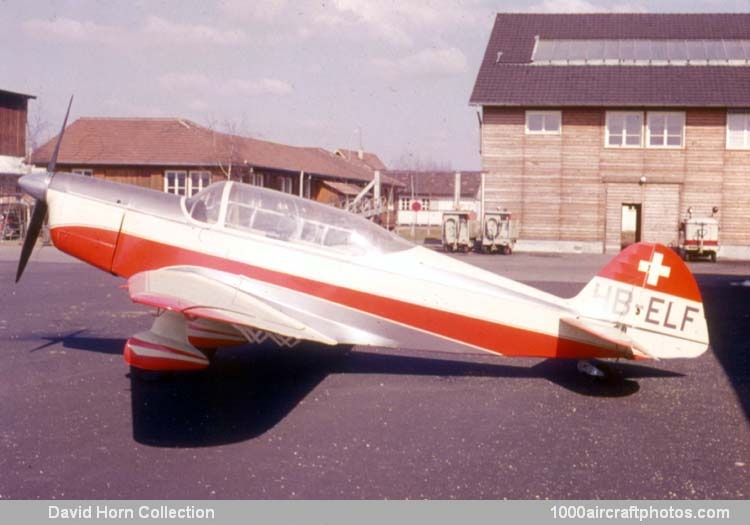Registered as D-3085 the pictured aircraft was delivered to the famous Hellmuth Hirth of Stuttgart in February 1934. Hirth was an early aviator and the 79th pilot gaining his German pilot license on March 27, 1911. The 814 aviators that obtained a German license before WW I were later effectively known as an "Alter Adler" (Old Eagle). Hirth became also well-known by the development of aero-engines.
By 1937 the D-3085 had been reregistered D-EUJA, and when Hirth died on July 1, 1938, ownership of the aircraft was passed to his younger brother Wolf. Wolf Hirth, also a well-known aviator, soaring-pioneer, and co-owner of the Schempp-Hirth Flugzeugbau (still a leading glider manufacturer), saved the aircraft through WW II. To prevent it being destroyed, the sole survivor of the Fieseler F 5 was flown from Stuttgart-Echterdingen to Switzerland, days before the end of the hostilities in Europe (May 8, 1945).
In 1946 it was sold to Max Dätwyler of Switzerland, who initially stored the aircraft. When the aircraft was registered in Switzerland as HB-ELF on October 26, 1960, the aircraft had been rebuilt and modified, featuring a completely covered cockpit and a tail wheel replacing the tail skid.
The aircraft changed hands in 1961 and 1963, and again in 1967 when Christian Schweizer and Robert Hasenfratz became the new owners. On July 26, 1968, HB-ELF crashed in the French part of the Birsigtal (Birsig valley, on French-Swiss border, southwest of Basel). Pilot Hasenfratz and the passenger were killed, the aircraft was destroyed."
Type: Two-seat light aeroplane for training or touring.
Wings: Low-wing cantilever monoplane, tapering in chord and thickness, with swept-back leading edge. Wings can be detached and folded back against fuselage and are fastened by conical bolts and quick-release joints to built-in center section. Slotted flaps along whole trailing edge, outer sections of these act as ailerons. Wooden construction. I-section spars. Plywood covering to rear spars. Remainder covered with fabric.
Fuselage: Rigidly-braced structure of welded high-tensile steel-tube. Fabric covering.
Tail unit: Monoplane type. Tail plane, strut-braced to fuselage and wire-braced to fin, is adjustable in flight. Wooden structure. Plywood covering. Fin of steel-tube with fabric covering. Rudder and elevators of wood, with fabric covering. All hinged on ball-bearings.
Landing gear: Cantilever type. Vertical members attached to main spars outside slipstream and placed far enough forward to prevent nosing over in soft ground or on sudden application of brakes. Oleo-cum-rubber-in-compression shock-absorber. 7 in (18 cm) travel. Low-pressure tires. Wheel fairing. Sprung tracking tail-skid.
Power plant: One 60 hp Hirth HM.60 or 80 hp Hirth HM.60R four-cylinder air-cooled inverted in-line engine. Fireproof bulkhead. Aft of this, aluminum fuel tank mounted on rubber.
Accommodation: Two open cockpits in tandem. Passenger above wing and pilot over trailing edge. Front seat takes back-type and rear seat-type parachutes. Large locker behind folding back of rear seat. Decking from rear cockpit to fin easily removable and space beneath can be used for carrying skis, spare airscrew, etc.
Controls: Dual controls. Adjustable rudder-bar. Tail-trimming lever in pilot's cockpit.
|
A |
HM 60 engine |
HM 60 R engine |
